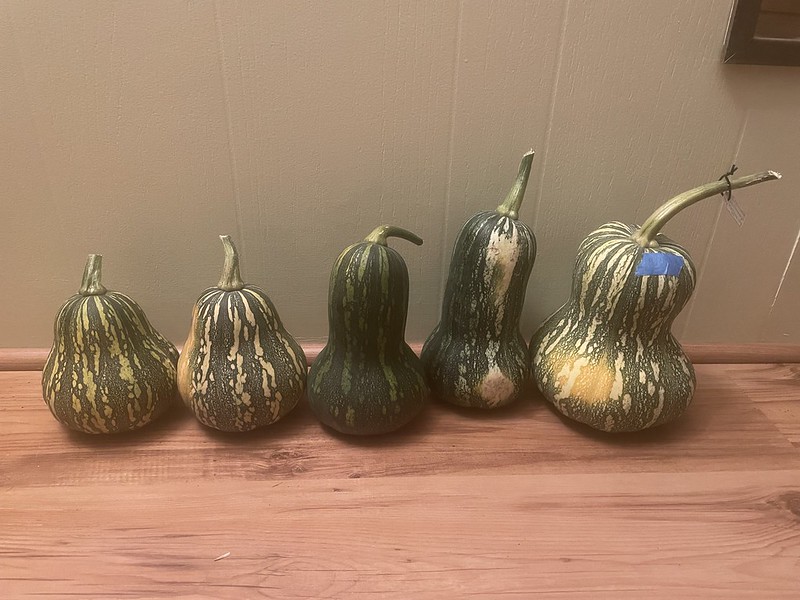guatemalan Green Ayote squash
Posted: Thu Jul 11, 2024 11:41 pm
This relatively rare, tropical landrace from Guatemala has just started to become commercially available in the US within the past few years. All of the US sources, as far as I can tell, appear to have the same "strain": they have a butternut squash shape, which suggest they're all likely of the same original source. If you search for pictures of the green ayote on the internet, you'll see pictures of the landrace growing in Guatemala with a wide range of shapes, but they're all shown to have that unique, deep green flesh. Did this green fleshed trait originate from introgression between a green fleshed argrosperma and C. moschata, or is this a mutation that happened strictly within moschata? The jury is still out there.
The original description for the US green ayote strain states that the growers think it's a cross between a tropical pumpkin and ayote (which is why a certain percentage of individual plants don't display the green fleshed trait). That said, I truly wonder why governments make it artificially extremely challenging for the general public to have access to a wide range of strains that are readily available in mexico, central, and south america, whereas in the rest of the world, they're seldom seen. Seeds are pretty easy to clean up and keep disease/pest free.
All that aside, here are some pictures of the Guatemalan Green ayote! First picture is the strain from Baker Creek: despite being fresh seeds, they appeared overly dried up and germination was around 60%. However, so far, their strain has mostly individuals with mottled leaves:

Highly mottled leaves on this individual:


I think the other source that I acquired these seeds from was Experimental Farms network (EFN), will have to double check. Seeds had a very high germination rate, near 100% and were in great shape. That said, there are a lot less individuals with mottle leaves, and I purposely selected only the most mottled looked leaved plants. The reason is if you look at the original landrace plants in Guatemala, they all have mottled leaves. Maybe the phenotypes not displaying mottled leaves is a way to "weed out" the individuals that don't display the green fleshed phenotype? I have no idea. Both my neighbor and I are growing out a few of the non-mottled individuals to see if that's true. Anyways, here's the EFN(?) strain, notice how different the leaves look from one individual to the next:

Some leaves aren't mottled at all:

The earliest fruit on a plant that produced semi-mottled leaves. I'm guessing the early trait came from the original hybridization event (aoyte x chinese pumpkin).

To be continued....
The original description for the US green ayote strain states that the growers think it's a cross between a tropical pumpkin and ayote (which is why a certain percentage of individual plants don't display the green fleshed trait). That said, I truly wonder why governments make it artificially extremely challenging for the general public to have access to a wide range of strains that are readily available in mexico, central, and south america, whereas in the rest of the world, they're seldom seen. Seeds are pretty easy to clean up and keep disease/pest free.
All that aside, here are some pictures of the Guatemalan Green ayote! First picture is the strain from Baker Creek: despite being fresh seeds, they appeared overly dried up and germination was around 60%. However, so far, their strain has mostly individuals with mottled leaves:

Highly mottled leaves on this individual:


I think the other source that I acquired these seeds from was Experimental Farms network (EFN), will have to double check. Seeds had a very high germination rate, near 100% and were in great shape. That said, there are a lot less individuals with mottle leaves, and I purposely selected only the most mottled looked leaved plants. The reason is if you look at the original landrace plants in Guatemala, they all have mottled leaves. Maybe the phenotypes not displaying mottled leaves is a way to "weed out" the individuals that don't display the green fleshed phenotype? I have no idea. Both my neighbor and I are growing out a few of the non-mottled individuals to see if that's true. Anyways, here's the EFN(?) strain, notice how different the leaves look from one individual to the next:

Some leaves aren't mottled at all:

The earliest fruit on a plant that produced semi-mottled leaves. I'm guessing the early trait came from the original hybridization event (aoyte x chinese pumpkin).

To be continued....






































